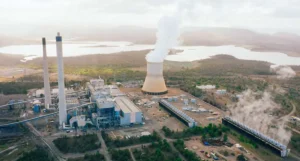 The number of new coal plants under development worldwide continues to fall dramatically with a new report revealing a 28 per cent fall in newly completed coal plants in 2017 compared to 2016.
The number of new coal plants under development worldwide continues to fall dramatically with a new report revealing a 28 per cent fall in newly completed coal plants in 2017 compared to 2016.
The report, Boom and Bust 2018: Tracking The Global Coal Plant Pipeline by Greenpeace, the Sierra Club and CoalSwarm, also revealed a 29 per cent fall in the number of plants on which construction commenced in 2017. (Disclosure: The author works for CoalSwarm, albeit on a different project.)
In 2017, the number of plants in the permitting and planning process fell by 22 per cent compared to 2016, bringing the decline to 59 per cent over the last two years.
The rapid decline in the number of coal plants being proposed, built and commissioned offers hope of achieving the 2015 Paris Agreement goal of limiting global warming to between a 1.5 °C and 2 °C temperature increase.
In 2016, the consultancy Climate Analytics estimated that to achieve the 1.5 °C or even the 2 °C target would require a rapid phasing-out of coal power generation.
However, achieving those climate goals requires acceleration of the rate of decommissioning of old plants and an end to new plants entering construction.
“The sum of all carbon dioxide emissions from coal plants operating and under development is 233 gigatonnes, higher than the budgets for 1.5 °C and 2.0 °C. In order to meet the 1.5 °C budget, all current development of coal plants must be cancelled and much of the current fleet must be retired before plants reach 40 years of age,” the report states.
According to the new report, on current trends, the capacity of closing old plants may exceed the capacity of newly commissioned plants in 2022.
India and China go cold on most new coal
Most of the recent cuts to new coal plant capacity are due to dramatic policy changes in China and India.
In China, the central government has imposed further curbs on the profligate coal plant building spree pursued by regional governments and power plant developers, often with support from provincial banks.
Faced with growing coal plant overcapacity and the prospect new coal plant building would undermine its efforts to cut air pollution, in 2017 the central government suspended hundreds of coal projects. Between them they had a capacity of 170,000 megawatts (MW).
All up, China has suspended 444,000 MW of new coal plant projects in the last two years. However, as the report makes clear, some of these decisions are tenuous with some plants suspended only until the end of 2017 and others until 2020. There are even 16,000 MW of coal plants which have notionally been suspended by central government agencies but where construction is proceeding nonetheless.
While China is moving to slash the coal plant boom at home, it is actively supporting it elsewhere around the world. According to Boom and Bust 2018 Chinese companies are involved in the construction, ownership or financing of 16 per cent of all coal power stations under development outside China.
In India, the transformation of the power sector has been driven by different factors.
Many private power projects are now stranded without access to private finance while some have either a guaranteed coal supply or a power purchase agreement. As private finance has dried up, all of the 6920 MW of new coal plants that began construction in 2017 are owned by government-owned utilities.
With a limited number of new coal projects proceeding in India and major investments in renewables accelerating, 2016–17 saw new renewables capacity outpace thermal power plant additions for the first time ever.
The new coal plant club gets smaller
As India and China curb coal, the pipeline of new coal plants is growing ever more confined to a smaller number of countries.
Although new coal units are under construction at 260 locations in 35 countries, an emerging trend is that new plants are entering construction in only a handful of countries.
In 2017, new coal plant construction commenced at more than one location in only seven countries: Bangladesh, China, India, Indonesia, Japan, Pakistan and South Korea.
In all these countries, growing civil society pressure, public alarm at pollution from coal plants and associated infrastructure and increased wariness of private banks and insurance companies suggests that the coal power plant boom of the last decade may be rapidly drawing to an end.
As new coal plant construction dries up, the prospect of ensuring a safe climate will hinge on how fast the existing fleet of old coal clunkers can be closed down.
Bob Burton is the Editor of CoalWire, a weekly bulletin on global coal industry developments published by CoalSwarm. (You can sign up for it here.) Bob’s Twitter feed is @BobBurtonoz.










